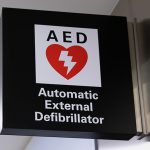When sudden cardiac arrest occurs, each link in the Chain of Survival becomes an important tool to help improve patient outcomes and promote recovery. The first link is the recognition of cardiac arrest and the activation of emergency response. The second link in the chain that we will focus on here — high-quality CPR — is vital to the continued circulation of both blood and oxygen, setting up the rest of the chain for success.
Every year, over 350,000 people experience out-of-hospital cardiac arrest. Unfortunately, only 1 out of every 10 of these people survive. In contrast to heart attacks, where blood vessels supplying blood to the heart muscle are blocked, cardiac arrest occurs when the heart stops beating completely, generally due to arrhythmia. Heart attacks don't usually result in cardiac arrest.
Why High-Quality CPR Matters
Providing immediate, high-quality cardiopulmonary resuscitation (CPR) is essential for improving survival rates. Updated CPR training programs help more individuals recognize this emergency and respond appropriately. More frequent training, coupled with personalized feedback, helps bridge knowledge gaps and improves skill retention so each person can approach CPR with confidence and competence.
Components of High-Quality CPR
Unlike in-hospital cardiac arrest, people experiencing out-of-hospital cardiac arrest depend on bystanders to begin CPR promptly while waiting for trained medical personnel to arrive on the scene. However, bystanders may not be trained to provide high-quality CPR. Unlike simple compressions, high-quality CPR is intended to maximize both circulation and ventilation through the achievement of specific metrics.
The four main components of high-quality resuscitation, with emphasis placed on chest compressions, include:
- A chest compression rate of 100–120 compressions every minute
- Compression depth of at least 2 inches (5 centimeters) for adults and at least 1/3 of the anterior-posterior dimension of an infant or child's chest
- No unnecessary ventilation for the patient
- Performance of high-quality chest compressions for at least 80% of the event
During this phase of the Chain of Survival, healthcare providers performing CPR should focus on providing high-quality chest compressions and mouth-to-mouth breathing. The American Heart Association recommends a compression-to-breath ratio of 30 to 2. Compressions of more than 2.4 inches (6 centimeters) in adults should be avoided.
It is also important to minimize interruptions to chest compressions while placing the hands in the correct position in the center of the chest. Anyone, including licensed healthcare providers, nonclinical staff members, and even novice bystanders, trained in CPR can provide high-quality resuscitation to those in need.
A Critical Link in the Chain of Survival
High-quality CPR maintains blood and oxygen circulation even when a patient is in full cardiac arrest. This first-line intervention sets the stage for further, more intensive links and treatments in the Chain of Survival, such as defibrillation and advanced resuscitation in a hospital setting. High-quality compressions may even help to reverse full cardiac arrest so that advanced resuscitation techniques are unnecessary. Quick action leads to greater survival rates for those experiencing cardiac arrest.
High-Quality CPR Education Opportunities for Healthcare Professionals
To improve survival rates, the American Heart Association and Laerdal Medical developed the Resuscitation Quality Improvement (RQI) Program, which connects providers with quarterly CPR education opportunities. The RQI Program's approach of more frequent, low-dose CPR education improves provider knowledge base and skills, in turn improving competence and confidence.
The program's design, which helps clinicians master CPR skills and expands their knowledge base, takes a different approach than traditional two-year CPR training. Most typical CPR classes occur only once every two years, which leads to knowledge and skill loss. In contrast, healthcare professionals using the RQI Program receive low-dose high-frequency education quarterly. More frequent CPR education leads to high-quality resuscitation, competence, and confidence and improves patient chances for survival.









